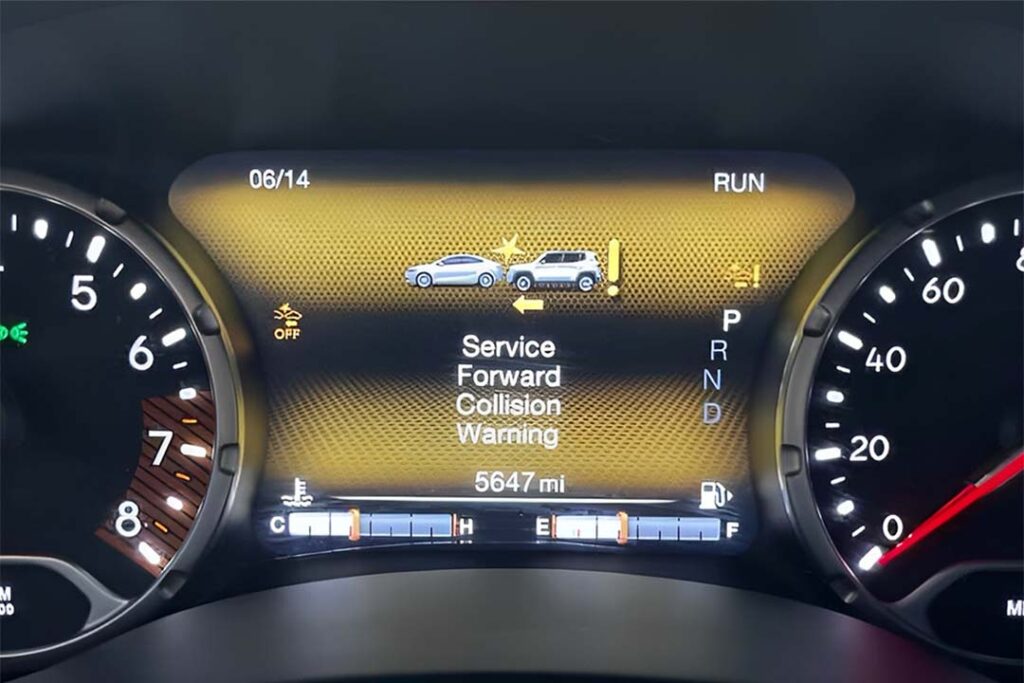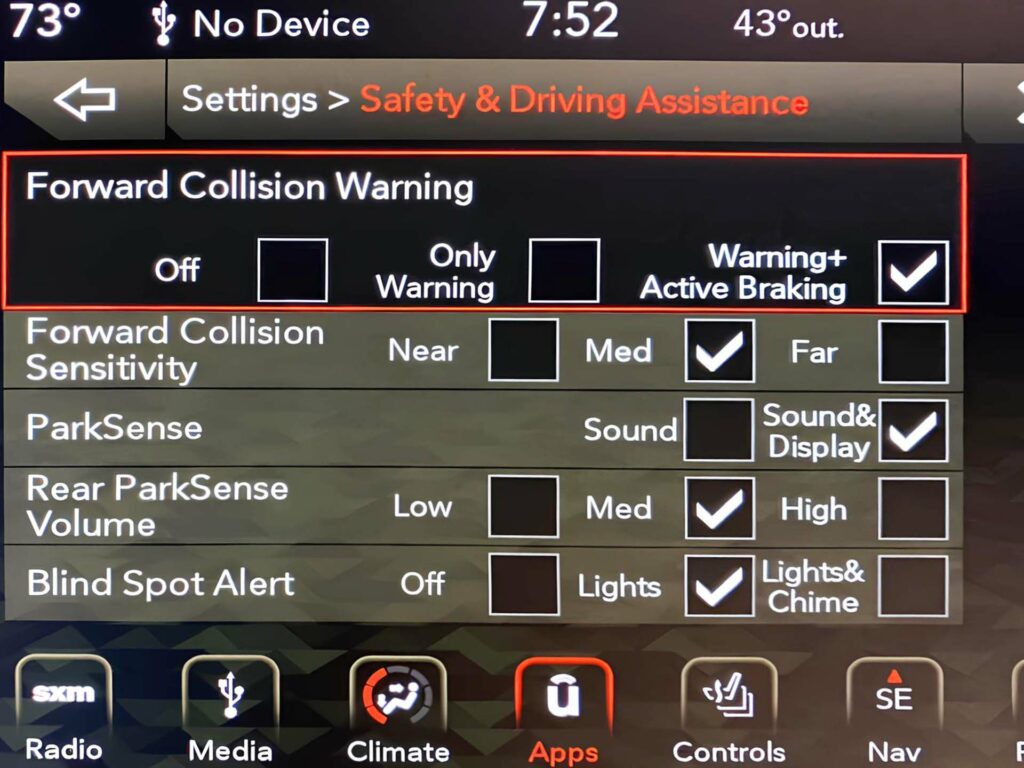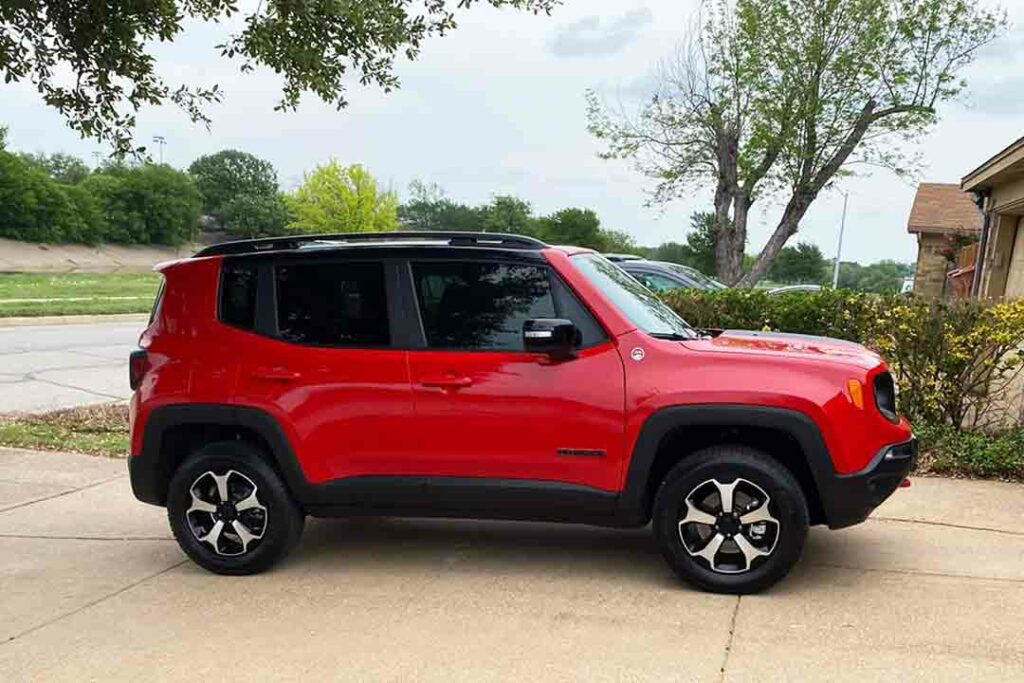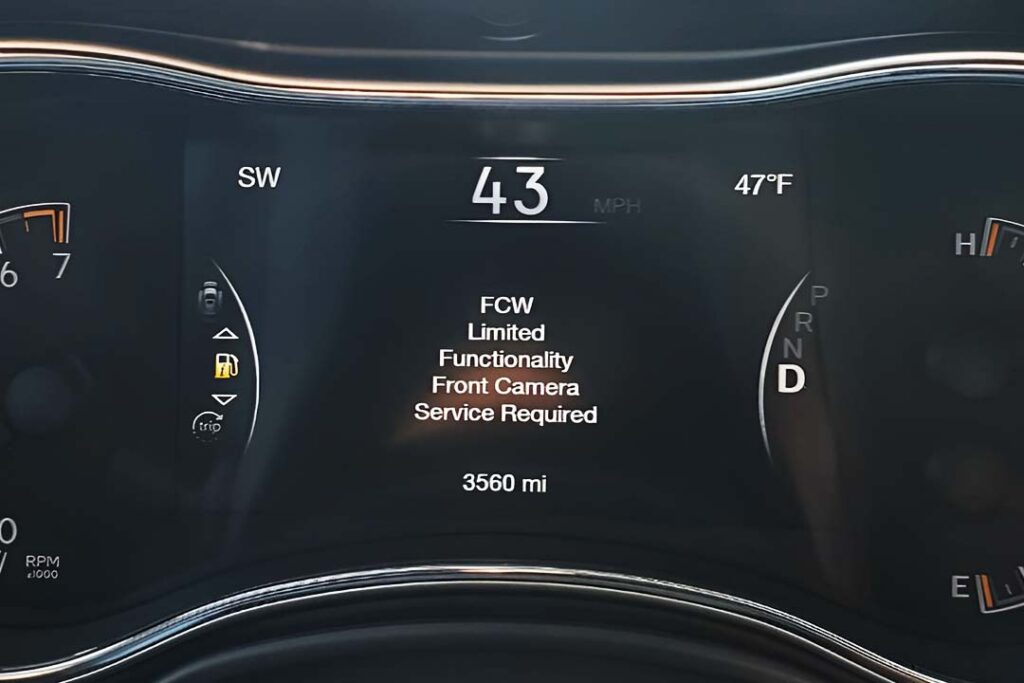Service Forward Collision Warning: 11 Common Causes And Their Fixes
Suppose you’re cruising down the road in your Jeep, enjoying the drive. Suddenly, a message pops up on your dashboard — Service Forward Collision Warning. You don’t want to see this kind of message when your Jeep’s cutting-edge technology is supposed to keep you safe. So, why is the Forward Collision Warning not working?
As a modern vehicle, Jeep has advanced features, including the Forward Collision Warning (FCW) system. Its purpose is to warn you of potential collisions ahead. However, when that Service Forward Collision Warning message appears, it signals something’s amiss.
Sensor-related issues, including dirt, breakage, misalignment, faulty connections, calibration problems, factory defects, and adverse weather conditions, along with camera and radar malfunctions, battery concerns, and software glitches, can trigger the Service Forward Collision Warning message in a Jeep.

This article sheds light on the functionality of Forward Collision Warning systems, how they contribute to road safety, and their role in alerting drivers to potential dangers. I’ll discuss the reasons behind this glitch and provide practical solutions to get your FCW back on track. Let’s navigate through the workings of Forward Collision Warning in your Jeep, ensuring you stay safe on the road using this fantastic technology. But first, you need to know how Forward Collision Warning works.
Table of Contents
What Is Forward Collision Warning?
Forward Collision Warning (FCW) is a driver safety and assistance feature that helps you avoid potential collisions and enhances driver vigilance. At its core, FCW is an advanced driver assistance system (ADAS) integrated into Jeeps.
Forward Collision Warning operates through an intricate network of sensors strategically positioned at your Jeep’s front bumper. These sensors function as the eyes of the system, continuously scanning the road ahead. There’s also a front-facing camera behind the rearview mirror and a radar in the middle of the front grille. Whether a sudden lane change by another vehicle, a pedestrian crossing the street, or a stationary object in the vehicle’s trajectory, these components work together to assess the space between your car and potential hazards diligently.
When the Forward Collision Warning system detects a potential collision, it communicates with you through a multi-faceted approach, using visual, audible, and sometimes tactile alerts. This is the system’s way of tapping you on the shoulder, providing a vital heads-up about impending danger.
The Forward Collision Warning takes safety a step further. It issues audible and visual warnings and may apply a haptic warning, resembling a brake jerk, to alert you about a potential frontal collision. These warnings are meticulously timed, allowing you to react, steer clear, or take evasive actions.
Forward Collision Warning doesn’t operate in isolation; it collaborates seamlessly with the vehicle’s emergency brake system. In the event of an imminent collision, the FCW system takes a proactive stance by sending signals to the emergency brake system if you don’t respond to the warnings to facilitate the timely and automatic application of a limited level of active braking to protect the vehicle from collision.
This intervention helps to slow down your Jeep and prevent collisions. The system provides additional brake force as needed if you apply brakes, but not with sufficient force.

Forward Collision Warning comes equipped with adjustable sensitivity settings. You can choose between ‘Far,’ ‘Medium,’ and ‘Near’ settings, influencing the system’s response to possible collisions. This adaptability ensures a dynamic driving experience tailored to your preferences. You can also choose between the warning levels, whether you only want the visual and audible warning or active braking to come on.
Now that you know about the Forward Collision Warning system, let’s learn what Service Forward Collision Warning means.
What Does Service Forward Collision Warning Mean?
If you encounter the message Service Forward Collision Warning in your Jeep, you must pay attention and understand it. This alert is not a casual warning on your instrument cluster; it’s telling you that the safety net of your vehicle is facing a potential internal hiccup. You can be in trouble anytime if active braking is enabled in your Forward Collision Warning settings.
You may also see the ACC FCW Unavailable Service Required or ACC FCW Limited Functionality warning on the instrument cluster. It indicates an internal system fault within the Forward Collision Warning (FCW) system. This issue is more prominent in the 2021 & 2022 Jeep Renegade, 2022 Jeep Compass, Jeep Grand Cherokee, and Jeep Wranglers.
While you can drive the vehicle under normal conditions despite this warning, you need to promptly address the issue. The FCW system, integral for proactive collision warnings and prevention, may not be fully operational, leaving a critical safety feature temporarily disabled.
Have your car checked as soon as you encounter this warning. Given the complexity of modern automotive safety systems, you should rely on the expertise of professionals to ensure diagnosis and appropriate resolution.
Although the vehicle is still drivable, you should exercise caution and remain conscious of the potential limitations of the Forward Collision Warning system. While routine driving is fine, you should avoid scenarios where the FCW system may be crucial, such as high-traffic areas or situations prone to sudden obstructions.
Now that you know what the error means, let’s determine why your Forward Collision Warning light is on.

What Are the Reasons Behind the Service Forward Collision Warning?
The Forward Collision Warning (FCW) system is an invaluable safety feature to prevent imminent threats. However, encountering a Service Forward Collision Warning message on your dashboard disrupts this crucial system. Let’s explore the potential causes behind this warning and find solutions to keep your safety features intact.
1. Dirty Front Sensor
One of the primary suspects behind FCW malfunctions is a dirty front sensor. On muddy roads or poorly constructed paths, your vehicle becomes a magnet for dust and mud, obscuring the sensor’s functionality. If you notice the warning message, consider cleaning the sensor.
Cleaning with warm water, car shampoo, and a microfiber cloth can restore the sensor’s functionality. Be cautious and gentle while cleaning the sensors.
2. Broken Sensor
Being very delicate by design, sensors can get damaged while driving, especially during overheating or accidents. Changing the supporting bracket or the wheel speed sensor may be necessary if the warning persists and you suspect any damage.
Always opt for professional replacement if you have a warranty, and ensure a visit to the dealership for a comprehensive inspection and potential reset.
3. Misaligned Sensor
A misaligned sensor can throw the Forward Collision Warning system into disarray. When you can’t realign the sensor, you’ll need a replacement. This misalignment may result from various factors, including windshield changes, accidents, repairs, or factory oversights.
In such cases, you’ll need to realign the sensor, preferably done by a professional, or replace the sensor.
4. Faulty Connection
Sometimes, the problem is as straightforward as a faulty connection. If the front of the vehicle underwent recent work, there’s a chance that someone forgot to plug the sensor back in. It can also be that the connection is loose.
Return to the last shop for a free check to quickly identify and rectify this potential oversight.
5. Calibration Issues
Issues with sensor calibration, triggered by external events such as being cut off by another vehicle, may cause the warning to appear. If your dealership can’t recalibrate, then they may resort to replacement.
If they do, addressing this promptly is crucial to ensuring the system’s proper functioning.
6. Factory Defect
In rare instances, the root cause of the Forward Collision Warning issue may be traced back to a factory defect. An example is neglecting the installation of the sensor bracket or other components during assembly.
If the problem persists despite various interventions, consult with the dealership to explore any factory-related oversights.
7. Driving in Bad Weather
Environmental factors, particularly adverse weather conditions, can influence your system’s reliability, triggering the Service Forward Collision Warning message.
Driving in severe weather, such as heavy rains or snowfall, can significantly reduce sensor visibility, leading to the Service Forward Collision Warning message. Water or ice accumulation near sensors, especially after intense rain or car washes, can interfere with the system.
These environmental factors are unpredictable, so it is challenging to preemptively address these system disruptions.
Exercise caution during adverse weather conditions. If visibility is compromised, take breaks until weather conditions improve, or the system regains functionality. Unfortunately, as it depends on unpredictable weather, there is no direct solution; patience and waiting for improved conditions are essential.
While light showers may not trigger the error, heavy rains can impact the system. Patience becomes crucial because once the environment is more hospitable, the system should return to normal. The system may return to normal functionality once the affected areas dry up. Acknowledge the unpredictability of nature and plan accordingly.
8. Camera Malfunction or Reduced Visibility
In the Forward Collision Warning (FCW) system, the role of the forward-facing camera is pivotal. However, encountering a Service Forward Collision Warning message on your dashboard can signal an issue with this vital component.
The forward-facing camera may encounter difficulty during calibration, leading to a malfunction. The camera module may sometimes experience premature failure. Environmental elements like dirt or moisture may affect the camera behind the rearview mirror, leading to false readings. Moisture intrusion into the camera module can cloud its functionality and trigger false warnings. Replacement parts for camera modules may be on backorder, leading to delays in resolving the issue.

You need assistance from the dealership. If calibration challenges persist, the dealership may need to order a replacement part, which could be subject to backorders. If your vehicle is within the warranty period, replace the camera module to ensure a resolution to the malfunction.
Inspect to check for any specks of dirt or moisture on the camera lens. Gently clean the lens if necessary.
If there’s any moisture, allow the affected area to dry thoroughly. In extreme circumstances, expert assistance may be needed to address moisture-related problems and possibly replace the camera module. Incorporate routine inspections during scheduled maintenance visits.
9. Blocked or Faulty Radar
The radar plays a starring role in the Forward Collision Warning (FCW) system. However, if you receive a Service Forward Collision Warning message, you may trace its origins to a blocked or faulty radar.
A radar malfunction can trigger unanticipated braking events, even in the absence of immediate threats. Shared fuses can lead to multiple component failures, potentially affecting the radar system.
Extreme weather conditions, such as heavy rain, snow, or mud, may alter the radar’s perception, prompting automatic deactivation for safety reasons.
Physical obstructions like stickers on the bumper cover or aftermarket license plate mounts can also interfere with radar functionality.
Excessive paint thickness on a replacement bumper cover can cause the radar to read incorrectly.
If your radar malfunctions, it may be necessary to replace the radar. If unexplained braking occurs, prompt intervention is crucial to avoid safety hazards.
Conduct a comprehensive inspection to identify blown fuses. If the radar issue results from a shared fuse problem, replacing the fuse and addressing the root cause is essential.
Exercise caution during adverse weather conditions. The system typically reactivates when regular visibility is restored. Awareness of the system’s sensitivity to environmental changes is crucial for understanding its temporary deactivation.
Conduct a visual inspection for any potential obstructions. Remove stickers, adjust license plate mounts, or address any issues that may hinder the radar’s unobstructed operation. During repairs or replacements, ensure that the paint thickness is within acceptable limits.
10. Battery Issues
When facing a Service Forward Collision Warning message, you may find its roots in battery-related issues.
An auxiliary battery that is not fully charged can lead to erratic errors in the vehicle’s electronics, including the FCW system. Weakness in either the main or auxiliary battery can result in error messages and malfunctions.
Inadequate charging of either the battery or the presence of corrosion on battery posts and sensors can trigger system errors. Issues with the Intelligent Battery Sensor (IBS) can disrupt the flow of electrical information, leading to errors in the FCW system.
Over time, batteries may degrade, impacting their ability to supply consistent power. Due to insufficient power, weak batteries can manifest as varied errors in vehicle systems, including the Forward Collision Warning.
Trickle charge both the main and auxiliary batteries to ensure they are fully charged. Additionally, clean the Intelligent Battery Sensor (IBS) on the battery post to establish a robust electrical connection. Regularly monitor battery health and address any signs of weakness promptly.
Ensuring a stable connection enhances the accuracy and reliability of electrical signals, minimizing the chances of errors. Proactive monitoring allows for the timely identification and replacement of weak or failing batteries, preventing potential errors in the Forward Collision Warning system.
11. Software Glitch
The Service Forward Collision Warning message may often appear because of a software glitch.
While aiming to enhance overall performance, recent computer updates may inadvertently introduce glitches impacting the Forward Collision Warning system. Software glitches may disrupt the calibration of the FCW system, leading to erratic behavior.
Sometimes, the lack of updated software versions can also contribute to the software glitch.
Persistent software-related issues may require in-depth diagnostics by your dealership to identify and rectify the root cause.
Keep a close eye on system behavior following any computer updates. If issues arise, promptly notify the dealership for further assessment and potential software recalibration. This ensures that the software aligns seamlessly with the Forward Collision Warning components, minimizing the likelihood of glitches.
Also, you can disconnect the battery and allow it to sit. This can act as a soft reset, potentially alleviating software glitches causing erroneous warnings.
Read More: Service Electronic Parking Brake: 8 Common Causes And Fixes
Final Words
The Forward Collision Warning (FCW) system is not merely a feature but a vigilant co-pilot. It actively minimizes potential hazards to keep you and your loved ones safe. The occasional appearance of the Service Forward Collision Warning message may cause momentary concern. Still, if you understand the intricacies behind this notification, you’ll find manageable solutions.
Service Forward Collision Warning is more than a message; it’s a prompt for a thorough check. Quick attention to any issues ensures your safety features work seamlessly, giving you confidence on the road.
I hope dealing with sensor, camera, radar, and battery matters is more straightforward for you now. Regular cleaning, timely fixes, and professional help keep your safety features like the Blind Spot Alert intact and ready for action.
Software glitches can be tackled, too. Keep an eye on updates, try a soft reset with your battery, and seek professional advice when needed. These steps ensure your collision prevention features work reliably.
Understanding these challenges turns uncertainty into informed action. Embrace a proactive mindset, use available solutions, and drive confidently, knowing your Jeep’s safety features are there to keep you secure on the ever-changing road.
